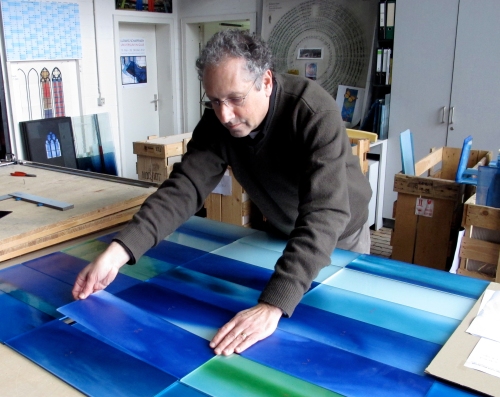 At Spaulding Rehabilitation Hospital in Boston, MA, architectural glass artist Paul Housberg has recently installed a new glass wall that visually connects the two stories of the facility’s main lobby and mezzanine. The piece, entitled Water Walk, creates a heightened sense of depth in a cramped corner, and seeks to evoke the peaceful movement of water, inspired by the hospital’s location on the Charlestown waterfront. The hospital hosts therapeutic aquatic activities for patients, such as water sports like canoeing, water-skiing, rowing, kayaking, sailing, paddle boating, and windsurfing.
At Spaulding Rehabilitation Hospital in Boston, MA, architectural glass artist Paul Housberg has recently installed a new glass wall that visually connects the two stories of the facility’s main lobby and mezzanine. The piece, entitled Water Walk, creates a heightened sense of depth in a cramped corner, and seeks to evoke the peaceful movement of water, inspired by the hospital’s location on the Charlestown waterfront. The hospital hosts therapeutic aquatic activities for patients, such as water sports like canoeing, water-skiing, rowing, kayaking, sailing, paddle boating, and windsurfing.
“Water traditionally plays a role in healing or is associated with healing,” Housberg said in a telephone interview with the GLASS Quarterly Hot Sheet. Like water, he hopes his wall will create “a calming and uplifting experience. I think a public work of art is successful when it offers that moment of reflection or contemplation.”
In collaboration with Derix Glass in Taunusstein, Germany, Housberg used milky, mouth-blown sheet glass to create the installation. He applied vitreous glass paints to the glass, fired it, and then cut the glass into rectangular tiles. The tiles were then arranged into a grid and laminated to a mirror.
 “Part of [its rectangularity] is practical and part of it is about lending a structure to the piece,” Housberg explained. “When you’re working within an architectural setting, specifically within this sort of setting, [the mirrored glass] helps bridge a gestural aspect with the architectural.”
“Part of [its rectangularity] is practical and part of it is about lending a structure to the piece,” Housberg explained. “When you’re working within an architectural setting, specifically within this sort of setting, [the mirrored glass] helps bridge a gestural aspect with the architectural.”
 Orientation and the consistency of lighting are some of the factors Housberg considers in such projects. Because of its location in the hospital, Water Walk could not be back-lit. Housberg responded by using the mirror as a means to “reflect ambient light with the mouth-blown glass. You get movement in it, and you get reflections. It’s sort of obscured like the surface of water.”
Orientation and the consistency of lighting are some of the factors Housberg considers in such projects. Because of its location in the hospital, Water Walk could not be back-lit. Housberg responded by using the mirror as a means to “reflect ambient light with the mouth-blown glass. You get movement in it, and you get reflections. It’s sort of obscured like the surface of water.”
Generally, Housberg is interested in exploring the relationship between art, glass, and architecture, which he believes is a lot about “expressing the material or the process.” In his technique, he begins with an architectural intent and tailors his technique to the nature of the specific site he is working with, “if it means developing a new technique or modifying an existing technique.”
In a past project at the Governor Philip W. Noel Judicial Complex, for instance, Housberg reflected the flat New England wetlands in another abstract, rectilinear design.
Housberg studied at the Rhode Island School of Design, where he received his BFA and his MFA. Later, he studied stained glass under artist Patrick Reyntiens in England and also studied glass at the International Center of Glass Research in Marseilles, France. His architectural glass installations are found at Princeton University, Mayo Clinic, and California State Teachers’ Retirement System Headquarters among other public and private locations.
—Gina DeCagna


